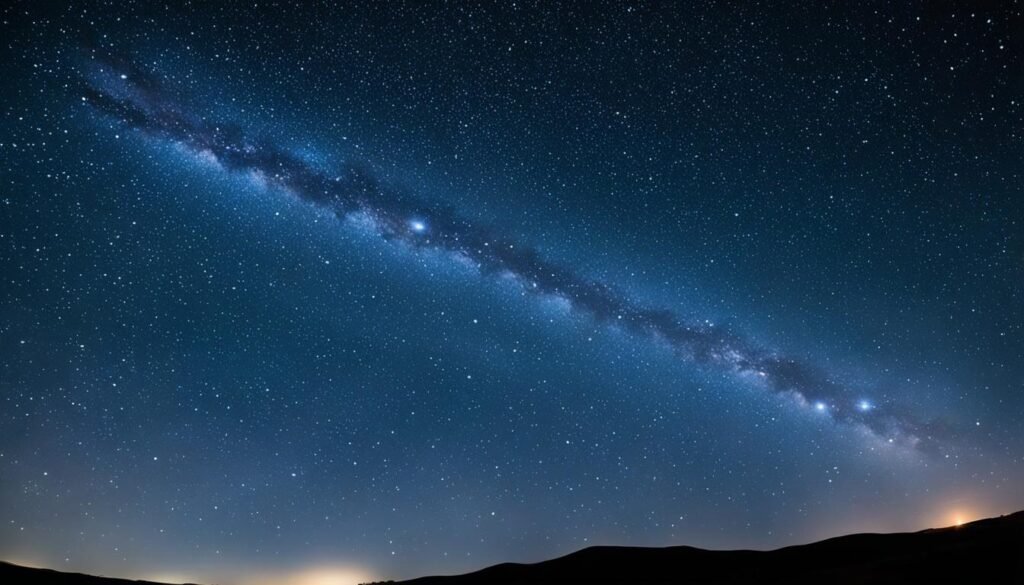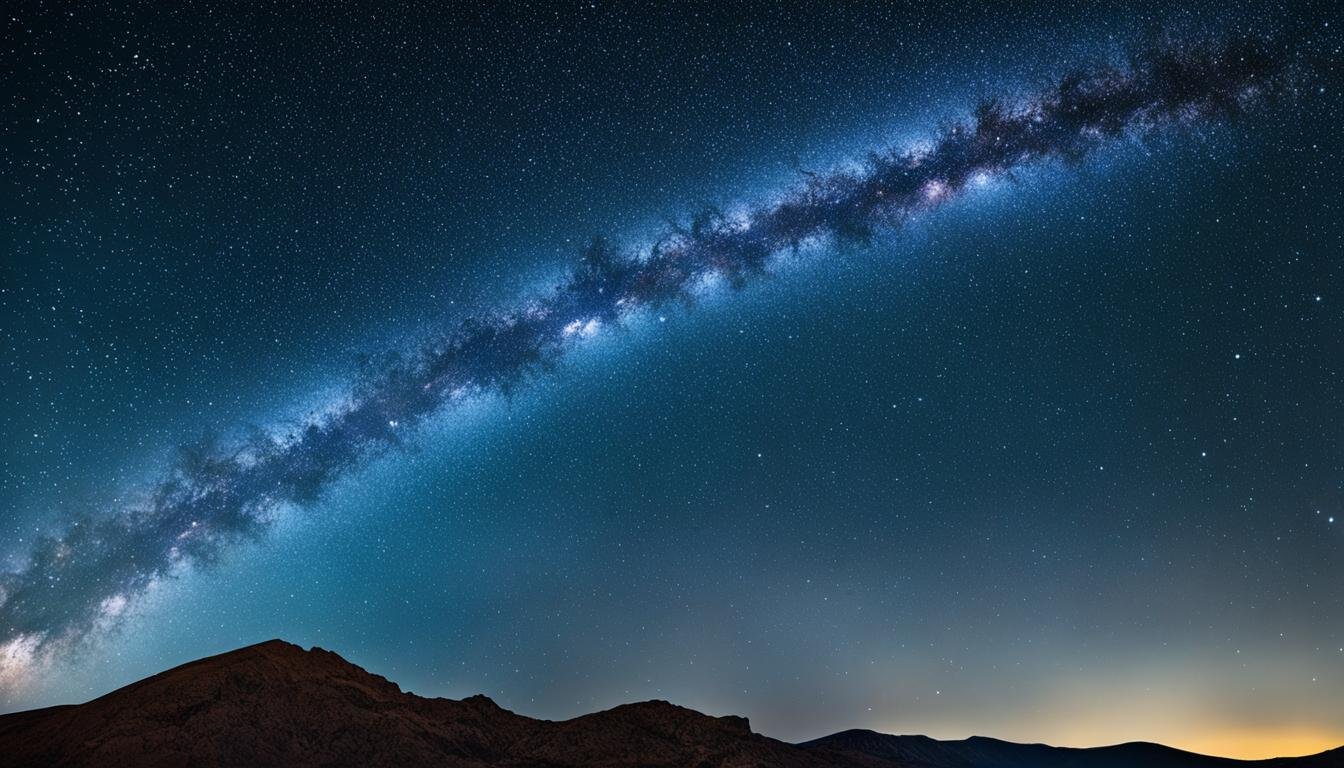As you gaze up into the celestial realm on a clear summer night, your eyes may trace the contours of the famed summer triangle asterism, a guiding beacon for stargazers and astronomers alike. This triangular asterism in the summer sky is composed of three brilliant stars: Vega, Deneb, and Altair. Each star heralds from a unique constellation—Lyra, Cygnus, and Aquila, respectively—but together they form an easily recognizable shape against the backdrop of the cosmos. Your journey through the night sky is about to be enlightened with this summer triangle guide, revealing the splendor of these star patterns in summer nights.
Key Takeaways
- Identify the three bright stars that form the summer triangle asterism: Vega, Deneb, and Altair.
- Understand the connection between the asterism and its constituent constellations: Lyra, Cygnus, and Aquila.
- Learn the cultural significance and navigational uses of this prominent triangular pattern in the summer sky.
- Receive guidance on the best times and methods to observe this celestial wonder.
- Discover the historical context and the role of Patrick Moore in naming the summer triangle asterism.
Unlocking the Secrets of the Summer Triangle Asterism
When you set your sights on the night sky, the celestial navigation summer triangle serves as a beacon for astronomers and stargazers alike. This is not just any random collection of stars, but the famous star formation summer triangle, a pattern recognized for binding together three of the most prominent constellations. Let’s delve into the cosmic triumvirate that outlines this remarkable asterism: Vega in Lyra, Deneb in Cygnus, and Altair in Aquila.
Vega, the brightest of the trio, dominates the constellation Lyra and leads the asterism with its piercing light. Deneb follows as the luminary of Cygnus, painting a stroke across the Milky Way with its tail. Completing the geometric marvel is Altair, the eye of Aquila, etching the final vertex of the triangle. These stars, luminaries within their own domains, are not bound by physical ties. Yet, their celestial alignment has created one of the most striking configurations in the heavens—a geometrically precise isosceles triangle.
Acclaimed Austrian astronomer Johann Joseph von Littrow was among the first to acknowledge this pattern back in 1839, recognizing it as a significant marker in the fabric of the night. The astronomy summer triangle — observable at various points of the year — not only punctuates the summer skies but also acts as an astronomical calendar, subtly heralding the shifts between seasons.
| Star in the Summer Triangle | Constellation | Apparent Magnitude | Distance (Light Years) |
|---|---|---|---|
| Vega | Lyra | 0.03 | 25 |
| Deneb | Cygnus | 1.25 | 2,600 |
| Altair | Aquila | 0.76 | 17 |
As you navigate this eternal compass, remember that each point of the Summer Triangle tells its unique story, locked in a dance with space and time. So when you next gaze upon the nocturnal canvas, allow the Summer Triangle to guide your celestial journey and unlock the secrets of the universe that surrounds us.
Navigating the Night Sky with the Summer Triangle
Imagine you’re under a sprawling canopy of stars on a warm summer night. Among these celestial jewels sits a distinctive formation that has guided humanity for centuries—the famous Summer Triangle. Tucked within its bounds, the stars Vega, Deneb, and Altair act as celestial navigators, marking their stance in the night sky with glowing certainty. Learn to master the art of celestial navigation with one of the night sky’s most prominent asterisms.
The Brightest Stars: Vega, Deneb, and Altair
Each corner of the triangular asterism in the summer sky is anchored by a bright star. They differ in brightness and distance from Earth, offering you a luminary tapestry that has endured the test of time in several cultures’ astronomical traditions. The brightest of the trio, Vega, sits just 25 light-years away, boasting a magnitude of 0.0, while Deneb, the most distant and luminous of the three, radiates from 3,000 light-years away. Completing the formation, Altair shines brightly less than 17 light-years distant. Together, these summer triangle stars create an unmistakable guide for night-time explorers.
Connecting Constellations: Lyra, Cygnus, and Aquila
Our stellar guides belong to a greater tapestry of summer triangle constellations. Vega is part of Lyra, a constellation also housing wonders like the Ring Nebula. Deneb crowns Cygnus – the swan, known for its array of deep-sky objects. And Altair is the beacon within Aquila, the Eagle, flanked by its own set of stars. Together, they stitch a rich tableau of history and celestial amazement that you can witness firsthand across the summer sky.
Celestial Navigation: Using the Summer Triangle for Orientation
As a tool for celestial navigation, the Summer Triangle is peerless. When Vega ascends in the east during a summer evening, it signals the commencement of the season. Through its placement and the positions of Deneb and Altair, the triangle provides a method to orient yourself while admiring the spectacle of the night sky. Whether through traditional stargazing or modern positional astronomy, the famous star formation Summer Triangle serves as a reliable seasonal marker, connecting you to the cosmos from wherever you stand.
Decoding the Magnificence of the Celestial Trio
As you delve into the world of stargazing, the Summer Triangle guide becomes your quintessential companion, introducing you to an awe-inspiring feature known in astronomy’s Summer Triangle. This celestial trio—Vega, Deneb, and Altair—has not only adorned our night sky with its geometric splendor but also serves as a celestial map, leading observers on a journey through the heavens.
The brilliance of the blue main-sequence star Vega is the starting point for our celestial exploration. Together with the overpowering luminosity of the supergiant Deneb and the fast-spinning star Altair, these astronomical beacons offer more than just a picturesque vision; they act as gateways to numerous other celestial wonders. Let’s examine the defining characteristics of this stellar trio that have secured their place in both the astral realm and the curiosity of astronomers.
- Vega: Not only does this star shine as a top-tier point of the Summer Triangle, but it also enables stargazers to locate the constellation Lyra, enriching our celestial search with its blue luminescence.
- Deneb: Resting in the body of Cygnus, this star outshines its counterparts and guides us toward the Milky Way’s most radiant deep-sky objects, signifying the expansive nature of our galaxy.
- Altair: As the beacon of Aquila, Altair’s rapid rotation demonstrates the dynamism of the Universe, providing a glimpse into the physical characteristics that influence stellar morphology.
Below lies a table that details the comparative aspects of these three stars at the heart of the Summer Triangle, revealing the intersections of distance, magnitude, and spectral types—the essential variables that both captivate and inform stargazers worldwide.
| Star | Average Distance (Lightyears) | Apparent Magnitude | Spectral Type | Notable Features |
|---|---|---|---|---|
| Vega (Lyra) | 25 | 0.03 (var) | A0 Va | Guidepost to Lyra constellation |
| Deneb (Cygnus) | 2,500 | 1.25 | A2 Ia | Luminosity superseding other first magnitude stars |
| Altair (Aquila) | 17 | 0.76 | A7 V | Fast rotation causing equatorial bulge |
Whether you’re an amateur astronomer or a seasoned sky-watcher, the Summer Triangle guide empowers you to navigate and appreciate the grandeur of these stars. As you gaze upward, remember that each star’s light has traveled an inconceivable distance to reach your eyes, offering a tangible connection to the vast and magnificent universe in which we reside.
Exploring the Constellations within the Summer Triangle
As you venture into the celestial wonders of the summer triangle constellations, you will encounter a myriad of stellar phenomena that are bound to fascinate. Each corner of this imaginary triangle opens up a portal to ancient myths, navigational lore, and the deep, expansive universe.
Lyra’s Luminous Vega and Its Surrounding Delights
At the heart of Lyra beats Vega, one of the brightest celestial beacons in the night sky. This shimmering star, also known as Lyra’s Vega, is surrounded by a treasure trove of cosmic spectacles that illuminate the tapestry of the heavens. Epsilon Lyrae, the captivating double-double star, and the picturesque Ring Nebula are just some of the intriguing celestial bodies embellishing the vicinity.

The Northern Cross of Cygnus and Deep-Sky Wonders
Stretching its wings across the sky, the constellation of Cygnus is home to the Northern Cross. Deneb, a star of first magnitude, stands as the luminary at the crest of this asterism. The Cygnus Northern Cross serves as a stellar guide, leading observers to discover the awe-inspiring North America Nebula and the soft glow of distant cosmic clouds found in the neighboring Cepheus constellation.
Aquila the Eagle and Its Starry Environs
Altair Aquila, a star famed for its rapid rotation and part of the constellation Aquila the Eagle, helps form the southernmost tip of the Summer Triangle. Alongside its ruddy companion Tarazed and the blue-hued Alshain, it carves a route through the galaxy’s rich band. Aquila delightfully contrasts with the dense field of stars, offering both a map and narrative to those navigating the night sky with the Summer Triangle.
Let this summer triangle guide lead you through the constellations that have enthralled humanity for millennia. Whether you are a seasoned stargazer or a novice, these dazzling formations are within your grasp, offering a natural spectacle that thrills and educates in equal measure.
summer triangle asterism
When you gaze up at the night sky during the warm summer months, your eyes are likely drawn to a distinctive configuration known universally as the astronomy summer triangle. This celestial guidepost is not only an astronomical wonder but also a cultural touchstone that has inspired stories and guided explorers for generations.
This striking asterism is made distinct by three primary stars, each residing in their own constellations. These bright beacons serve as the vertices of an immense triangle, visible even in urban areas where light pollution obscures fainter stars. Here is a closer look at the individual stars:
- Vega: Dominating the constellation Lyra, it is among the brightest stars in the summer sky and has been observed since antiquity.
- Deneb: Part of the Cygnus constellation, it is famed for its significant luminosity despite its vast distance from Earth.
- Altair: The principal star of Aquila, noteworthy for its rapid rotation which flattens the star at the poles.
Together, they form the star patterns in summer that have helped navigators determine direction and have graced the skies of countless mythologies and folklores. Beyond simple navigation, the Summer Triangle serves as a remarkable starting point for amateur stargazers aiming to familiarize themselves with the night sky’s treasures.
Apart from its brilliance and ease of location, the Summer Triangle serves as a seasonal guidepost. Its apex, Vega, reaches its highest point in the sky during the heart of the summer season, imparting a rhythm to the year that few other asterisms can match.
Whether you’re a seasoned observer or a curious onlooker seeking to delve into the realms of the cosmos, the astronomy summer triangle provides you with a spectacular celestial display. It represents a collective imagination stretching back through time and across cultures, persistently echoing the beauty of the stars above. So this summer, take a moment to look up and allow this astronomical triangle to guide your gaze and your imagination through the depths of the celestial landscape.
Stellar Activities: Viewing and Photography Tips for the Summer Triangle
Embarking on a journey to capture the beauty of the famous star formation Summer Triangle can be a fulfilling experience for both astrophotography enthusiasts and star gazers alike. With the right techniques and timing, you can take stunning photos and enjoy the starry spectacle that graces the summer sky. Here are some expert tips to guide you through your celestial endeavours.
Best Practices for Astrophotography in Summer Months
Astrophotography firm DeepSkyStacker recommends aiming your DSLR’s wide-angle lens towards the heavens on a moonless night for best results. Using the manual bulb setting allows for long exposures capturing the faintest lights of the universe. Your camera sensor’s sensitivity to the broader spectrum will be increased by a modification allowing you to capture more detail of the nebulae in the navigating the night sky with Summer Triangle.
Picking the Perfect Night for Star Gazing
For an optimal experience in star gazing, plan your session on a clear night, away from the light pollution of urban areas. As Vega, Deneb, and Altair rise in the east, they signal the ideal season for observing the Summer Triangle guide, painting a breathtaking view over the celestial canvas. Tracking their positions throughout the year also enriches your understanding of the night sky’s rhythm.
Utilizing Tools for Locating the Triangular Asterism in Summer Sky
Star charts and planetarium software are useful tools for any enthusiastic star gazer looking to locate the Summer Triangle asterism. By identifying Vega, Deneb, and Altair, one can easily connect these points to unveil the grand triangle spanning across Lyra, Cygnus, and Aquila—an awe-inspiring sight during your star gazing adventures.

To further aid your exploration, below is a useful guide detailing the optimal settings for photographing the celestial trio that forms the Summer Triangle.
| Camera Setting | Recommendation |
|---|---|
| Lens Type | Wide-angle |
| Exposure Mode | Manual Bulb |
| File Format | RAW |
| ISO Setting | Adapt to darkness |
| Additional Equipment | Sturdy Tripod, Remote Shutter Release |
By adhering to these astrophotography techniques and carving out time on moonless nights, you’re all set to capture the enchanting display of the summer triangle. Whether you are simply observing or photographing, the Summer Triangle serves not just as a guide through the cosmos, but a canvas that lets us unleash the beauty of the stars above.
Astronomy’s Famous Star Formation: The Summer Triangle’s Place in Culture and History
The famous star formation Summer Triangle, featuring the stellar vertices Vega, Altair, and Deneb, is more than just a collection of bright stars; it is a cultural and historical marvel. This asterism, known to astronomers and stargazing aficionados around the globe, was brought to the forefront of modern astronomy by the esteemed British astronomer Patrick Moore. Its influence, however, extends far beyond the academic domain and into the realm of storytelling.
Throughout history, the Summer Triangle has been a celestial guidepost, with Vega and Altair forming part of the traditional Chinese love story of the Weaving Maiden and the Cowherd—lovers separated by the vast river of the Milky Way, who may only unite once a year. This tale, among others, fosters a rich tapestry of mythology that intertwines with the stars’ progression through the heavens, illustrating the deep connections between astronomy’s Summer Triangle and human culture.
As you look upwards to the stars, remember that the Summer Triangle is not solely an asterism to identify but also a portal to the past, an expanse where science and myth coalesce. Its legacy is etched in the night sky and the collective memory of civilizations across time. The Summer Triangle remains a celestial compass by which we navigate not just space, but our place within a storied universe.
A Guide to Summer Triangle Stars and Their Attributes
Your journey through the night sky is incomplete without witnessing the grandeur of the Summer Triangle stars—Vega, Deneb, and Altair. Each of these celestial beacons is a storybook in itself, intricately woven into the fabric of the summer sky. As you explore their attributes, your understanding of these stars will deepen, enhancing your appreciation for the stellar tapestry they adorn.
Vega: A Stellar Beacon of the Summer Sky
When you lift your gaze towards the constellation Lyra, Vega greets you with its brilliant blue-white radiance. This stellar neighbor, a mere 25 lightyears away, exemplifies the Vega summer sky, offering a beacon for both seasoned astronomers and cultural storytellers. Vega’s luminosity, more than fiftyfold that of our Sun, marks it as an indispensable feature of the Summer Triangle guide and remains one of the most pivotal celestial markers in the night sky.
Deneb: The Distant Luminary of Cygnus
Deneb’s brilliance pierces the celestial dome from within the constellation Cygnus, highlighting the summer triangle stars. This A2 Ia supergiant’s glow emanates from around 3,000 lightyears away, earning it the title of a distant luminary. Among the pantheon of stars that make up the famed asterism, Deneb – with its staggering luminosity, which overshadows even the brightest stars – stands out as a source of awe, deeply etched in the narrative of Deneb Cygnus and the broader cosmic landscape.
Altair: The Rapid Rotator of Aquila
Altair, a pivotal point of the Summer Triangle constellations, presents an extraordinary phenomenon with its swift rotation rate, which it evident in its non-spherical shape. The compelling features of this star, resident in the constellation Aquila, make it an emblematic element of the Altair Aquila narrative. Less than 17 lightyears from Earth, Altair’s swift spin and remarkable structure contribute to the rich tapestry of mythology and astronomy surrounding the Summer Triangle.
FAQ
What is the Summer Triangle asterism and which stars form it?
The Summer Triangle asterism is a notable pattern in the summer night sky, consisting of three bright stars: Vega from the constellation Lyra, Deneb from Cygnus, and Altair from Aquila. Together they create a prominent triangular shape that is easy to spot.
Why is the Summer Triangle important for celestial navigation?
The Summer Triangle serves as an excellent navigational tool in the night sky because its three bright stars are prominent and widely recognized. Vega, Deneb, and Altair can be used to orient oneself and serve as markers for tracking seasonal changes.
Can I see the Summer Triangle throughout the year?
Yes, while it is most prominent and high in the sky during the summer months, the Summer Triangle can be viewed at different times throughout the year, signalling the shift of the seasons.
What constellations do the stars of the Summer Triangle belong to?
The stars of the Summer Triangle are part of different constellations: Vega is the brightest star in Lyra, Deneb is the luminary of Cygnus, and Altair is the most luminous star in Aquila.
How does the Summer Triangle guide me in identifying other constellations?
The Summer Triangle asterism acts as an anchor point in the night sky. By locating Vega, Deneb, and Altair, you can then explore the surrounding constellations of Lyra, Cygnus, and Aquila, along with their varied celestial objects such as nebulae and star clusters.
What makes the stars of the Summer Triangle special?
Each star of the Summer Triangle has unique characteristics that add to its allure. Vega is near and luminous, Deneb is one of the most radiant stars observable from Earth due to its supergiant status, and Altair is celebrated for its rapid rotation and oblate shape.
Are there any tips for photographing the Summer Triangle?
For astrophotography, use a DSLR camera with a wide-angle lens, shoot in manual mode during moonless nights, and in RAW format. Opt for dark locations away from city lights, and consider stacking multiple exposures to enhance the final image.
What tools can help me find and learn more about the Summer Triangle?
You can use star charts, apps, and planetarium software to identify the stars of the Summer Triangle and learn more about their positioning and the connected constellations. These tools are especially helpful in visualizing and finding celestial objects in the night sky.
What cultural significance does the Summer Triangle hold?
The stars of the Summer Triangle, particularly Vega and Altair, are part of various myths and legends around the world. The asterism is culturally important across different civilizations and has inspired stories and traditional navigation practices for centuries.
How can I best view the Summer Triangle?
To view the Summer Triangle, find a dark sky area away from light pollution during the summer months. Look towards the eastern sky as Vega, Deneb, and Altair rise on summer evenings. The pattern is quite large and can be gazed upon without the aid of telescopes or binoculars.






